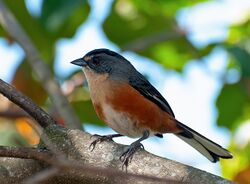Biology:Microspingus
| Microspingus | |
|---|---|

| |
| Buff-throated warbling finch (Microspingus lateralis) | |
| Scientific classification | |
| Domain: | Eukaryota |
| Kingdom: | Animalia |
| Phylum: | Chordata |
| Class: | Aves |
| Order: | Passeriformes |
| Family: | Thraupidae |
| Genus: | Microspingus Taczanowski, 1874 |
| Type species | |
| Microspingus trifasciatus Taczanowski, 1874
| |
| Species | |
|
See text | |
Microspingus is a genus of warbler-like birds in the tanager family Thraupidae. They are found in highland forest in South America.
Taxonomy and species list
A molecular phylogenetic study published in 2014 found that the genus Poospiza was polyphyletic.[1] In the resulting rearrangement to create monophyletic genera the genus Microspingus was resurrected. It had been introduced in 1874 by the Polish zoologist Władysław Taczanowski with the three-striped hemispingus as the type species.[2][3][4] The genus name combines the Ancient Greek mikros meaning "small" with spingos meaning "finch".[5]
The genus Microspingus is the sister taxon to a clade containing the black-backed bush tanager in the monospecific genus Urothraupis and the Pardusco in the monospecific genus Nephelornis.[1][3]
The genus contains eight species:[4]
| Image | Common Name | Scientific name | Distribution |
|---|---|---|---|
 |
Buff-throated warbling finch | Microspingus lateralis | Brazil. |
 |
Grey-throated warbling finch | Microspingus cabanisi | eastern Brazil, far eastern Paraguay, far north-eastern Argentina, and Uruguay |
 |
Rusty-browed warbling finch | Microspingus erythrophrys | Argentina and Bolivia |
 |
Plain-tailed warbling finch | Microspingus alticola | Peru. |
 |
Ringed warbling finch | Microspingus torquatus | Argentina, Bolivia, and Paraguay. |
 |
Three-striped hemispingus | Microspingus trifasciatus | Bolivia and Peru. |
 |
Black-capped warbling finch | Microspingus melanoleucus | Argentina, Bolivia, Brazil, Paraguay and western Uruguay. |
 |
Cinereous warbling finch | Microspingus cinereus | Brazil. |
References
- ↑ 1.0 1.1 Burns, K.J.; Shultz, A.J.; Title, P.O.; Mason, N.A.; Barker, F.K.; Klicka, J.; Lanyon, S.M.; Lovette, I.J. (2014). "Phylogenetics and diversification of tanagers (Passeriformes: Thraupidae), the largest radiation of Neotropical songbirds". Molecular Phylogenetics and Evolution 75: 41–77. doi:10.1016/j.ympev.2014.02.006. PMID 24583021. https://digitalcommons.lsu.edu/cgi/viewcontent.cgi?article=3613&context=biosci_pubs.
- ↑ Taczanowski, Władysław (1874). "Description des oiseaux nouveaux de Pérou central" (in French). Proceedings of the Zoological Society of London: 129–140 [132]. https://www.biodiversitylibrary.org/page/28502217.
- ↑ 3.0 3.1 Burns, K.J.; Unitt, P.; Mason, N.A. (2016). "A genus-level classification of the family Thraupidae (Class Aves: Order Passeriformes)". Zootaxa 4088 (3): 329–354. doi:10.11646/zootaxa.4088.3.2. PMID 27394344.
- ↑ 4.0 4.1 Gill, Frank; Donsker, David; Rasmussen, Pamela, eds (July 2020). "Tanagers and allies". IOC World Bird List Version 10.2. International Ornithologists' Union. https://www.worldbirdnames.org/bow/tanagers/. Retrieved 26 October 2020.
- ↑ Jobling, James A. (2010). The Helm Dictionary of Scientific Bird Names. London: Christopher Helm. p. 254. ISBN 978-1-4081-2501-4.
Wikidata ☰ Q22265256 entry
 |

